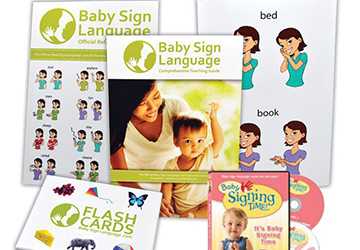How to Teach Your Baby Sign Language
Embarking on the adventure of teaching your baby sign language is like opening the door to a world of early communication and heartwarming connections. Imagine the joy of understanding your little one's needs before they can utter a single word and sharing in the excitement of their first attempts at self-expression through sign language. This guide will dive into four practical tips to make your baby's sign language journey accessible and enjoyable. From the magic of the first signs to the laughter-filled moments of shared understanding, let's explore how you can seamlessly incorporate sign language into your baby's world. Get ready for a delightful journey of communication and connection!

Start Early and Be Consistent:
The key to successful baby sign language is to start early and be consistent in your efforts. Babies are like sponges, absorbing information from their surroundings. Begin introducing signs when your baby is around six to eight months old, as this is when they start developing the motor skills needed for basic hand movements.
Consistency is crucial. Choose a set of signs you want to introduce and stick with them. Repetition is your friend in teaching your baby sign language. Use the signs consistently in various situations, such as during playtime, mealtime, or diaper changes. This repetition helps your baby associate the signs with specific actions or objects, facilitating quicker learning.
Select Simple and Relevant Signs:
When choosing signs to teach your baby, keep it simple and relevant to their daily life. Opt for signs that represent essential concepts like "eat," "drink," "more," and "all done." These basic signs can significantly improve communication and reduce frustration for you and your baby.
Introducing signs that relate to your baby's interests can also make the learning process more engaging. If your little one loves animals, teach signs like "dog," "cat," or "bird." Use visual aids like pictures or toys to reinforce the connection between the sign and the object. This visual reinforcement helps babies grasp the meaning more effectively.
Incorporate Signs into Daily Routines:
Integrate baby sign language into your daily routines to make it a natural part of your baby's communication development. For instance, during mealtime, use signs like "eat," "drink," and "more" to communicate with your baby about food and beverages. As you change their diaper, introduce signs like "diaper" and "clean."
Consistency in incorporating signs into routines reinforces their relevance, making it easier for your baby to grasp their meaning. It's like building a language bridge between you and your little one, allowing them to express their needs and desires before they can verbalize them.
Be Patient and Celebrate Successes:
Learning any language takes time; the same goes for baby sign language. Be patient with your baby's progress and celebrate even minor successes. When your baby attempts to mimic a sign or successfully uses one, acknowledge and praise them. Positive reinforcement encourages continued learning and builds confidence in their ability to communicate.
Additionally, pay attention to your baby's cues and expressions. If they seem interested or engaged when you use a particular sign, they are starting to understand its meaning. Keep the atmosphere light and enjoyable, turning learning into a fun and interactive experience.
Use Repetition and Reinforcement:
Repetition is a cornerstone in the learning process for babies. Consistent repetition of signs helps reinforce their understanding and memory. Repeat signs regularly, especially those that are crucial for daily communication. Repetition provides the necessary practice for your baby to grasp the signs and associate them with specific meanings.
To enhance the learning experience, incorporate visual and tactile reinforcement. Point to objects, use facial expressions and touch the items related to the signs. For example, when teaching the sign for "ball," show them a ball, let them feel it, and say the word aloud. This multisensory approach deepens their understanding and makes learning more interactive and enjoyable.
Encourage Imitation and Participation:
Babies learn by imitating the actions of those around them. Encourage your baby to mimic your signs by making them playful and interactive. Use exaggerated facial expressions, hand movements, and excited tones to capture their attention and make the learning experience enjoyable.
Create opportunities for your baby to participate actively in the signing process. When introducing a new sign, involve them in the action. For instance, if you're teaching the sign for "wave," guide their hand in a waving motion. This hands-on approach reinforces the sign's meaning and encourages active participation, making learning a collaborative and engaging experience.
Expand Vocabulary Gradually:
As your baby becomes comfortable with the initial set of signs, gradually introduce new signs to expand their vocabulary. Introducing too many signs at once may overwhelm them, so take a gradual approach. Choose signs that align with their developmental stage and interests.

Consider incorporating signs for family members, everyday objects, or activities your baby encounters regularly. This gradual expansion ensures the learning process is enjoyable and manageable for your baby. It also allows you to tailor the signs to their evolving needs and interests, promoting continuous engagement and growth in sign language skills.
Create a Sign-Friendly Environment:
To reinforce your baby's learning, create an environment that encourages the use of sign language. Label everyday items in your home with signs and corresponding pictures. For example, label the high chair with the sign for "eat" or the diaper changing area with the sign for "diaper."
Use sign language in social settings, such as playdates or interactions with family members. When others use signs, it reinforces the consistency and widens the exposure to different signing styles. A sign-friendly environment promotes a holistic learning experience for your baby, helping them generalize their sign language skills across various situations and interactions.
Conclusion:
Teaching your baby sign language is a rewarding and fulfilling journey that enhances early communication skills. Starting early, choosing simple and relevant signs, incorporating them into daily routines, and being patient are the keys to success. Remember, the goal is to create a bridge of understanding between you and your baby, fostering a deeper connection and laying the foundation for effective communication in the future. Enjoy the process, celebrate the milestones, and savour the joy of communicating with your little one in your language.





